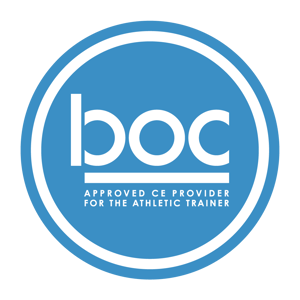Functional Performance Measures in Geriatric Rehab

Description
This course is an evidence-based overview of functional performance measures in geriatric rehabilitation. It examines the history, theoretical background, and types of performance and outcome tools, as well as why they are important. It also presents an in-depth review of select instruments commonly used with older patients to assess mobility, balance, and overall functional abilities, covering the specifics of each tool and when they are most appropriate to use. The course also includes a literature review of three recent research articles that use functional performance measures with older adults. This course focuses attention on how to use functional performance measures to thoroughly evaluate a patient in order to create a plan of care that will help increase their safety, mobility, and ability to complete daily activities. The information presented will be relevant and immediately useful in clinical care for any rehab professional who works with older adults.


Physicourses is an AOTA Approved Provider of professional development. Course approval ID# 6295. This distance learning-independent course is offered at 0.4 CEUs Intermediate Level, OT Service Delivery, Foundational Knowledge. AOTA does not endorse specific course content, products, or clinical procedures.
Available Course Credits
| Alaska State PT & OT Board | 4.00 | ||
 |
AOTA | 4.00 | |
| Arizona State Board of Physical Therapy | 4.00 | ||
 |
BOC | 4.00 | |
| California Physical Therapy Board | 4.00 | ||
 |
Colorado Physical Therapy License Board | 4.00 | |
| Delaware Examining Board of Physical Therapists and Athletic Trainers | 4.00 | ||
| District Of Columbia Department of Health | 4.00 | ||
| Georgia State Board of Physical Therapy | 4.00 | ||
| Hawaii Board of Physical Therapy | 4.00 | ||
| Idaho Physical Therapy Licensure Board | 4.00 | ||
| Indiana Physical Therapy Board | 4.00 | ||
| Iowa Board of Physical Therapy and Occupational Therapy | 4.00 | ||
| Kansas State Board of Healing Arts | 6.00 | ||
| Kentucky Board of Physical Therapy | 4.00 | ||
| Maine Board of Physical Therapy | 4.00 | ||
| Massachusetts Board of Allied Health Professionals | 4.00 | ||
| Michigan Board of Physical Therapy | 4.00 | ||
| Mississippi State Board of Physical Therapy | 4.00 | ||
| Missouri Advisory Commission for Physical Therapists | 4.00 | ||
| Montana Board of Physical Therapy Examiners | 4.00 | ||
| Nebraska Department of Health and Human Services | 4.00 | ||
| New Hampshire Occupational Therapy Governing Board | 4.00 | ||
| North Carolina Board of Physical Therapy Examiners | 4.00 | ||
| North Dakota Board of Physical Therapy | 4.00 | ||
| Office of Professional Regulation, Vermont Secretary of State | 4.00 | ||
| Oregon Board of Physical Therapy | 4.00 | ||
| Pennsylvania Bureau of Professional and Occupational Affairs - Physical Therapy | 4.00 | ||
| South Carolina Board of Physical Therapy | 4.00 | ||
| South Dakota Physical Therapy License Board | 4.00 | ||
| State of Alabama Board of Physical Therapy | 4.00 | ||
| State of Rhode Island Department of Health | 4.00 | ||
| Tennessee Board of Physical Therapy | 4.00 | ||
| Utah Physical Therapy Licensing Board | 4.00 | ||
| Virginia Board of Physical Therapy | 4.00 | ||
| Washington State Board of Physical Therapy | 4.00 | ||
| West Virginia Board of Physical Therapy | 4.00 | ||
| Wisconsin Physical Therapy License Board | 4.00 | ||
| Wyoming Board of Physical Therapy | 4.00 |
Course Procedure
- Enroll in the course.
- View the course content.
- Take the test. (You must score 80% to pass. If you do not pass, you may retake the test.)
- Print your certificate of completion.
Course Content
| Functional Performance Measures in Geriatric Rehab | Module | ||
| Course Evaluation | Module |
Course Objectives
At the completion of this course, the rehab clinician will be able to:
- Identify what functional performance measures (FPMs) can assess
- Recall the history of the clinical use of FPMs
- Differentiate between different types of functional performance measures, outcome measures, and similar instruments
- Identify how impairments relate to functional deficits
- Delineate factors to consider in selecting the correct FPM for specific patients
- Recall why mobility measures, balance and fall risk measures, and functional measures are important in geriatric assessment
- Identify at least 3 mobility measures and 4 balance measures commonly used with older adults and recall their parameters, use, and interpretation
- Choose and apply one or more appropriate FPMs to use in a given case scenario
- Recall the focus and conclusions of each of the three included research articles and indicate how they may apply to clinical practice
235 Functional Performance Measures in Geriatric Rehab—Table of Contents
HOUR 1
Course Instructions 2
About the Authors 3
Course Description and Course Objectives 4
Table of Contents 6
Chapter 1—Introduction: Focus on Function 9
Chapter 2—Background and History 14
Why Do We Measure Functional Performance?
History of Functional Performance Measures (FPMs) 16
Case Example: The Evolution of Common Sense 17
Theoretical Background 19
WHO ICF Model
Impairments as Related to Function 21
Case Example: Patient-Specific Goals
Case Example: Lower Extremity Strength 22
Definitions 23
What Are We Measuring? 24
Chapter 3—Using Functional Performance and Outcome Measures 26
Types of Functional Performance and Outcome Measures
Physiological Measures
Condition-Specific Outcome Measures 27
Self-Report Measures 28
Performance-Based Measures 29
Single Dimension Measures 30
Multidimensional Measures
Limitations of FPMs 30
Factors Affecting the Choice of FPMs 31
The Importance of Using Standard Procedures 34
Where to Find FPMs 35
Chapter 4—Self-Report Measures 37
Falls Efficacy Scale International (FES-I) 38
Activity-Specific Balance Confidence Scale (A-SBC) 39
Geriatric Depression Scale (GDS)
HOUR 2
Chapter 5—Single-Activity Mobility Measures 41
Gait Speed
Distance Walk Tests 42
Sit-to-Stand Test 47
Floor Transfer Test 50
Timed Up and Go (TUG) 52
Dual-Task TUG 55
Chapter 6—Multi-Activity Mobility Measures 57
Physical Performance Test (PPT)
Short Physical Performance Battery 59
Chapter 7—Multidimensional Instruments 61
Functional Independence Measure (FIM)
Outcome and Assessment Information Set (OASIS) 63
Short Form (36) Health Survey (SF-36) 64
Chapter 8—Static and Dynamic Balance Tests 66
Balance and Fall-Risk Measures
Static Balance Tests 67
Romberg Test
Tandem Stance (Sharpened Romberg) Test 68
Single Leg Stance Test 70
Dynamic Balance Test 72
Four-Square Step Test
HOUR 3
Chapter 9—Multi-Activity Balance Performance Measures 76
Berg Balance Scale
Tinetti Performance Oriented Mobility Assessment 78
Balance Evaluation Systems Test (BEST) 81
Fullerton Advanced Balance Scale 83
Community Balance and Mobility Scale 85
Dynamic Gait Index 88
Functional Gait Assessment 90
Stopping Elderly Accidents, Deaths and Injuries (STEADI) 92
Case Example: Choosing a Balance Measure 94
Chapter 10—ADL, IADL, and Frailty Measures 96
Katz Index of Independence in Activities of Daily Living (ADL)
Lawton Instrumental Activities of Daily Living (IADL) Scale 97
Tilburg Frailty Indicator (TFI) 99
HOUR 4
Chapter 11—Literature Review 100
Huang W-NW, et al. Association between fear of falling and seven
performance-based physical function measures in older adults: a
cross-sectional study (10 pages)
Jędrzejczyk M, et al. Relationship between multimorbidity and disability
in elderly patients with coexisting frailty syndrome (10 pages)
Papp ME, et al. Changes in physical activity levels and relationship to balance
performance, gait speed, and self-rated health in older Swedish women: a
longitudinal study (9 pages)
Chapter 12—Conclusion 102
References 103
Sarah R.Stillings, MA, PT, MPT, CHT
Sarah R. (Sally) Stillings is a PT and Certified Hand Therapist in Texas. She received her physical therapy degree from the University of North Carolina at Chapel Hill. Prior to becoming a therapist, Sally taught university-level writing courses and was assistant editor of The Journal of Craniomandibular Practice. In her extensive career as a PT, she has held a variety of clinical, teaching, administrative, and business roles, including general PT practitioner, upper extremity specialist, clinic manager, hand therapy clinic coordinator, continuing education (CE) instructor, and CE course administrator. She has also served as Executive Director of the Kellermann Foundation, a U.S. nonprofit organization supporting healthcare and community development in Uganda, East Africa. Her work now focuses on creating evidence-based CE materials for rehab professionals. Sally is a lifelong runner who celebrates all those who cover the ground.

Customer Cancellation:
Customers may request cancellations of their enrollment or subscription in our digital or live educational services, subject to the terms outlined below. Cancellation requests must be made in writing, either through email or through our designated cancellation process.
Refund Policy:
Refunds will be provided according to the following guidelines: i) For cancellation requests made within 5 days of the initial enrollment or subscription, a full refund will be issued. Refunds will be issued using the same method of payment used for the original transaction, unless otherwise agreed upon in writing.
Provider Cancellation:
In the event Physicourses cancels your course, you will be issued a full refund or transfered to a course of equal or greater value.
Physicourses Conflict of Interest Disclosure Policy for Authors and Staff:
All persons in a position to control the content of any educational activity (authors or staff from Physicourses) are required to disclose to Physicourses any potentially biasing or potential conflict of interests in relationships of a financial, professional, or personal nature.
The intent of this disclosure is not to prevent authors or staff with commercial affiliations from planning an educational activity, or to prevent a Presenter with commercial affiliations from presenting, but rather to inform Physicourses of any potentially biasing relationships so that conflicts are resolved prior to the activity.
It is the policy of Physicourses to ensure balance, independence, objectivity and scientific rigor in all of its continuing education activities. All relevant conflicts of interest identified by the planner, presenter, or as determined by Physicourses will be disclosed to the audience verbally and in writing prior to the start of the presentation.
Definitions for Authors/Staff:
Relevant financial relationships are those relationships in which you benefit by receiving a salary, royalty, intellectual property rights, gift, speaking fee, consulting fee, honoraria, ownership interest (e.g., stocks, stock options, or other ownership interest, excluding diversified mutual funds), or other financial benefit. Financial relationships can also include “contracted research” where the institution gets the grant and manages the funds and you are the principal or named investigator on the grant.
Educational Level: Intermediate
Target Audience: PT, PTA, OT, OTA
Course Completion Requirements: Passing an online exam with 70% or greater will be required to earn continuing education credit
This course is approved for 0.4 CEUS. 4 contact hours
Physicourses is committed to ensuring accessibility to the most extensive audience possible. If you have any questions or special needs requests, please contact us at info@physicourses.com.